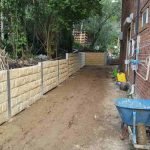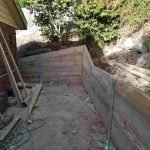Introduction
Building a retaining wall is more than just stacking stones or positioning timber; it's an art that mixes engineering concepts, style aesthetic appeals, and practical performance. As we look into From Concept to Conclusion: A Day in the Life of a Retaining Wall Builder, you'll find the complexities associated with this remarkable profession. Whether it's dealing with concrete sleepers, H beams, or lumber sleepers, every element plays a pivotal role in making sure that the structure not just looks great however likewise stands the test of time.
What is a Maintaining Wall?
A maintaining wall is a structure created to hold back soil and avoid erosion on sloped surface areas. These walls are important for preserving landscape integrity and can be made from various materials such as stone, wood, and concrete.
The Role of a Retaining Wall Installer
A retaining wall installer is accountable for transforming plans into tangible structures. They work closely with architects and landscape designers to make sure that the ended up product meets both practical and visual criteria.
Understanding the Different Types of Maintaining Walls
Concrete Sleepers
Concrete sleepers are pre-cast blocks utilized for their toughness and durability. They provide outstanding assistance for heavy loads and are resistant to rot and insect damage.

H Beams
H beams use considerable structural support due to their shape, making them perfect for taller keeping walls where additional strength is required.
Wood Sleepers
Though aesthetically attractive, wood sleepers require routine maintenance due to their susceptibility to decay. Nevertheless, they can supply a warm visual that mixes well with natural landscapes.
Timber Sleepers
Timber sleepers are frequently used in residential jobs where less height is required. They can create a rustic charm however come with issues about longevity.
Stone Maintaining Walls
Stone walls are timeless and can add enormous value to homes. Their natural look makes them popular in landscaping styles however needs experienced workmanship for proper installation.
The Initial Assessment: What Occurs First?
During the initial consultation phase, a retaining wall contractor meets with customers to discuss their needs and preferences. This phase includes website evaluations, comprehending drain problems, and figuring out material choices.
Planning & Design Stage: Crafting the Blueprint
Once preliminary conversations conclude, detailed plans are produced. This strategy includes measurements, material specs (be it concrete sleeper or stone), and drainage solutions.
Permits & Regulations: Browsing Legalities
Before building begins, securing required authorizations is essential. Building regulations differ by location; thus comprehending local regulations makes sure compliance throughout the project.
Preparing the Website: Clearing & Excavation Work
Preparing the website involves clearing greenery and particles followed by excavation work. This step lays the structure for a structurally sound keeping wall.
Material Selection: Choosing The Right Components
Selecting materials lines up carefully with style objectives while likewise thinking about spending plan restrictions. Elements like toughness (concrete vs. timber sleeper) play a vital role in this decision-making process.
Foundation Work: The Importance of Stability
A strong foundation is non-negotiable when developing any maintaining wall. Whether utilizing H beams or stone, guaranteeing stability prevents future collapses or shifts.
Construction Process: Step-By-Step Execution
Lay Out The Plan
Utilizing stakes and string lines helps envision where each component will go.
Excavate For The Base
Digging makes sure that water will drain properly away from the wall.
Install Drain Solutions
Correct drain systems prevent soil saturation behind walls.
Constructing The Wall
Depending on selected products (like concrete sleepers), walls might be built layer by layer.
Backfilling
Once set up, backfilling assists support the structure while making sure adequate drainage.
Finish Work

Tools of The Trade: Vital Equipment For Builders
Having a selection of tools at your disposal makes all tasks easier:
- Shovels & & Picks Levels Compactors Trowels Power Tools
Quality Control Measures Throughout Construction
Quality control ensures that every aspect satisfies industry standards:
- Regular Inspections Material Testing Adherence To Plans
Addressing Challenges On-Site: Problem-Solving Abilities Required
No building and construction job goes off without a hitch! From unexpected weather changes to material shortages-- being versatile is key!
Final Touches: Visual Enhancements For Your Keeping Wall
After building comes beautification:
Landscaping around it Adding plants or lighting Painting or staining wood structuresMaintenance Tips For Durability Of Retaining Walls
To extend the life of your keeping wall:
- Regularly examine for fractures Clean particles Check drain systems
Common FAQs About Maintaining Walls
1. What materials are best for building retaining walls?
Choosing between concrete sleeper, stone, timber sleeper depends upon aesthetic choice and structural requirements.
2. How high can my maintaining wall be?
Local policies https://tuffstuffretainingwalls.com.au/ dictate height limitations; typically between 4-- 6 feet without special permits.
3. Do I need preparing permission?
In most cases yes; examine regional building codes before starting construction.
4. Can I install a maintaining wall myself?
While DIY is possible, hiring professionals ensures safety and compliance with regulations.
5. How do I maintain my retaining wall?
Regular evaluations need to concentrate on checking for cracks or drainage issues; immediate repair work improve longevity!
6. Are maintaining walls expensive?
Costs vary based on materials selected(e.g., wood vs stone)along with labor costs involved.
Conclusion
In conclusion, constructing a keeping wall includes meticulous planning from start to finish-- thus why understanding every step in this journey from idea through conclusion matters profoundly! From picking materials like concrete sleepers or timber to browsing legal requirements-- it's clear how detailed this procedure really is! So next time you see one standing tall versus nature's forces-- take a minute to value all that entered into developing it!